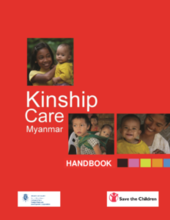This Handbook produced by Save the Children aims to provide guidance, primarily for Save the Children staff, NGO partners, Community Child Protection Groups and community volunteers in Myanmar, although the authors hope that it will also be used by responsible government bodies. It is based on the outcome of a workshop organized by Save the Children in Yangon, May 2013 and is informed by the international Guidelines for the Alternative Care of Children (2009). It clarifies that the intention of the Handbook is not to formalise kinship care but to provide guidance to community groups and community members in protecting the welfare of children living with extended family members. It highlights that communities in Myanmar have historically and traditionally cared for and protected orphaned, abandoned and vulnerable children within the extended family. Many children have been left with grandparents, older siblings, aunts, uncles and others as parents migrate to other areas or neighbouring countries for work. The majority of kinship care situations are informal, having been arranged by parents themselves or within the family. In most cases, it does not mean that children are actually moving from one household to another as households in Myanmar usually consist of the large extended family. When parents leave, the children will often remain where they are and it is simply the household dynamics and care arrangement that change. The care arrangement is traditionally discussed and determined by family members or community elders, and there is no involvement of the government or external agencies. In most cases, the family (typically the father’s relatives) discusses which family member will take in the child and the wider family network tries to support the family during the initial placement period by collecting funds and material goods.
The handbook highlights the benefits of kinship care but also some of the risks associated with it, and discusses the range of possible support needs which kin carers and children in their care could benefit from, with a particular focus on mitigating against the risk of unfair treatment of those children. The guidance underlines the key role of community level Child Protection Groups (CPGs) in identifying the needs for support and conducting assessments to ensure protection concerns and support needs are addressed. In that context, the Handbook differentiates between ‘support’ and ‘supervision’, the latter being used by CPG member or volunteer to gain access to the family and supervise the care of a child who is particularly at risk where the family is reluctant to accept support. The Handbook lays out a Support and Supervision Framework to help identify how much effort to put into providing support and supervision to families providing kinship care and sets out a 9 Steps Process for Supporting Kinship Care.
©Save the Children

